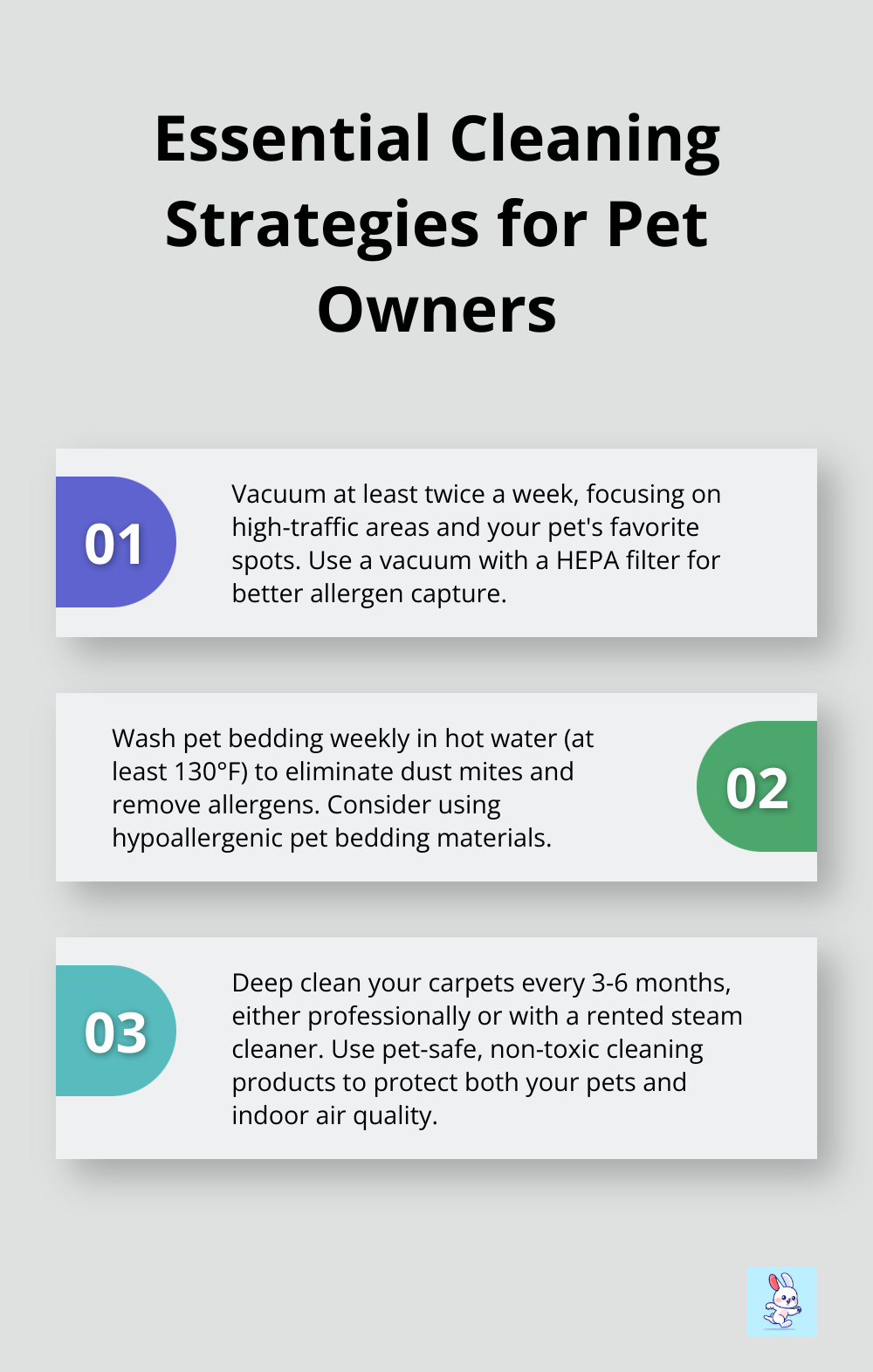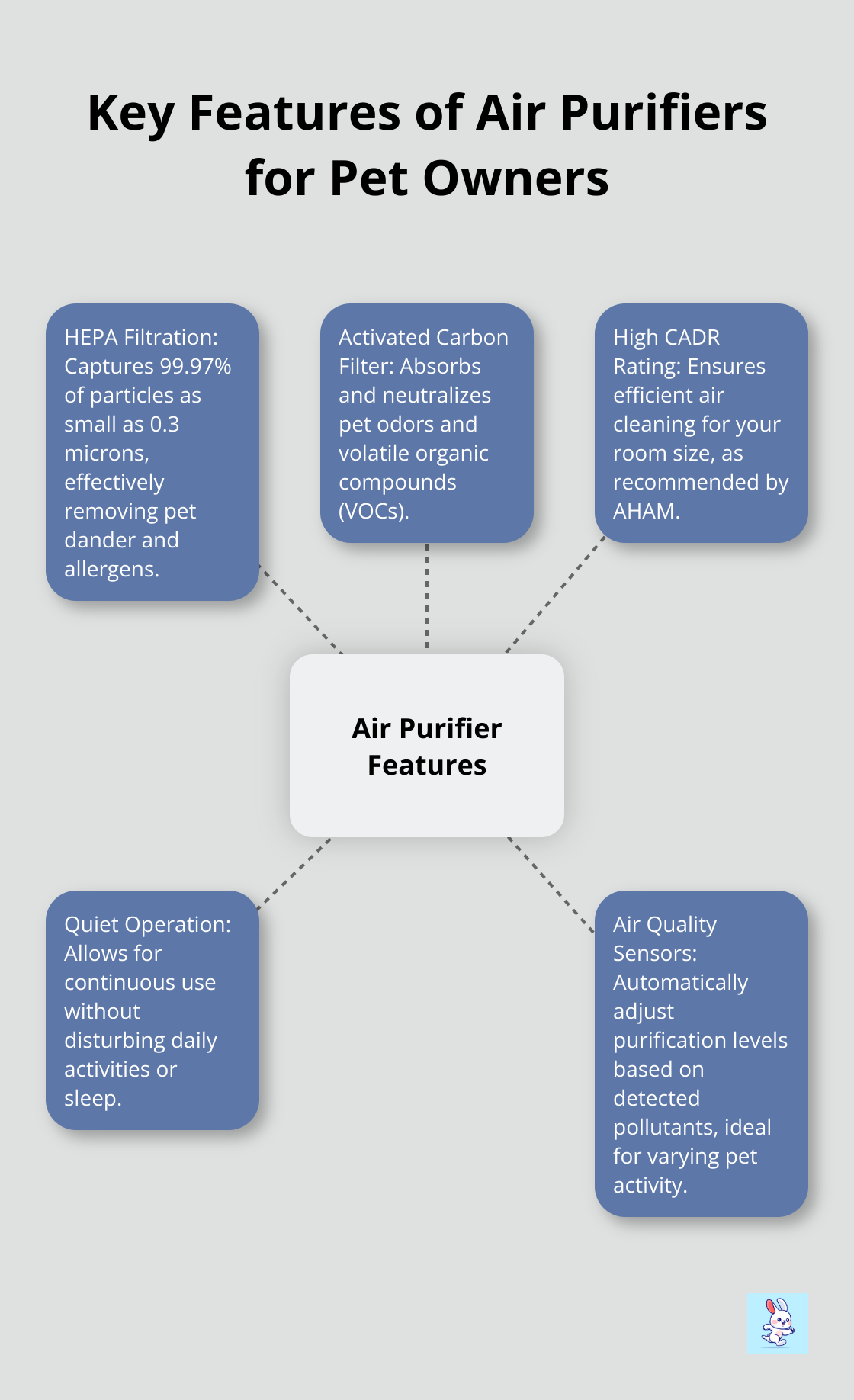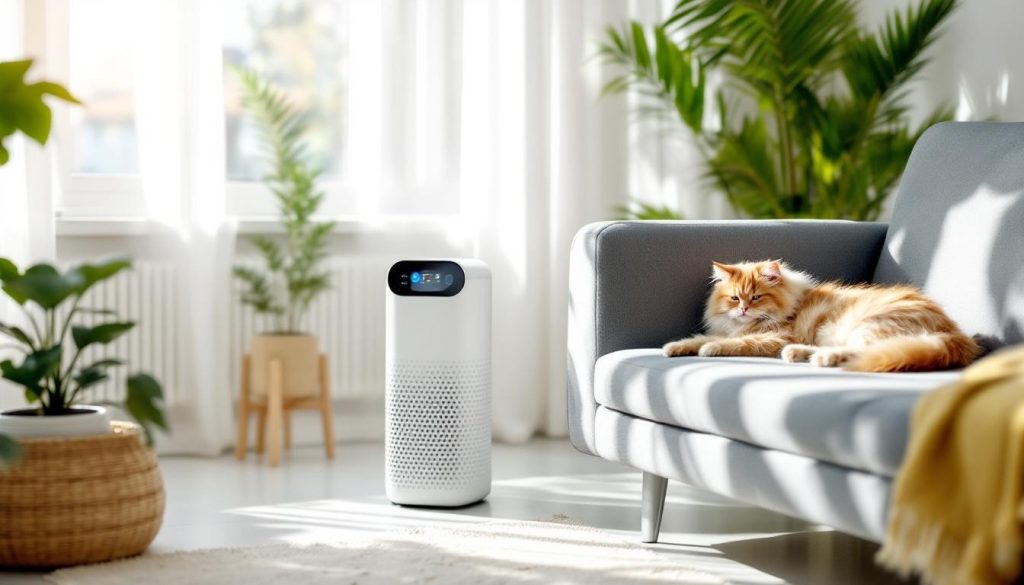Pets bring joy to our lives, but they can also impact indoor air quality. At Cleaning Rabbit, we understand the challenge of maintaining a clean home while keeping our furry friends happy.
Pet dander removal is a key concern for many pet owners, as these tiny particles can trigger allergies and respiratory issues. This blog post will guide you through practical strategies to create a pet-friendly home without compromising air quality.
How Pets Impact Indoor Air Quality
The Invisible Threat: Pet Dander
Pet dander, which consists of tiny skin flakes shed by animals, poses a significant air quality challenge in homes with pets. These microscopic particles float in the air for hours and settle on various surfaces. Coming into physical contact with pet dander can cause contact dermatitis, or a skin rash, hives or trigger a person’s asthma.
Beyond the Visible: Fur and Hair
While pet fur and hair are easy to spot, their effect on air quality often goes unnoticed. These particles act as carriers for allergens, dust, and other pollutants throughout your home. To combat this issue, pet owners must prioritize regular grooming and vacuuming.
The Nose Knows: Pet Odors and VOCs
Pets introduce various odors into homes, often caused by volatile organic compounds (VOCs). These compounds can irritate eyes, noses, and throats, and sometimes lead to headaches or dizziness. The Environmental Protection Agency (EPA) warns that some VOCs may have long-term health effects.
HVAC Systems Under Strain
Pet-related pollutants significantly affect home HVAC systems. Fur, dander, and other particles accumulate in air filters, which reduces their efficiency and potentially leads to poor air circulation. This buildup strains HVAC systems, potentially shortening their lifespan and increasing energy costs.
Health Risks: More Than Just Sneezes
The health risks associated with pet-related air pollution can be serious (especially for individuals with pre-existing respiratory conditions or allergies). Symptoms range from mild (sneezing, itchy eyes) to severe (difficulty breathing, asthma attacks). Scientists at NIEHS found that more than 50% of households have a dog, cat, or both.

While these challenges exist, pet owners can maintain good air quality with proper management. Regular cleaning, proper ventilation, and air purification significantly reduce these risks. Air duct cleaning and HVAC sanitation play a crucial role in maintaining healthy indoor air quality for pet owners.
In the next section, we’ll explore effective cleaning strategies that pet owners can implement to combat these air quality issues and create a healthier home environment for both humans and pets.
How to Keep Your Home Clean with Pets
The Power of Effective Vacuuming
Vacuuming is your primary defense against pet-related pollutants. Try to vacuum at least twice a week, with a focus on high-traffic areas and your pet’s favorite spots. Use a vacuum equipped with a HEPA filter to improve respiratory health by trapping tiny allergens, dust mites, and bacteria. For optimal results, vacuum in multiple directions to lift embedded pet hair and dander from carpets and upholstery.
Don’t overlook areas like baseboards, corners, and under furniture. These spots often accumulate significant amounts of pet hair and dander. For hardwood or tile floors, follow up with a microfiber mop to catch any remaining particles.
Pet Bedding and Toy Maintenance
Pet bedding and toys collect dander, saliva, and odors. Wash your pet’s bedding weekly in hot water (at least 130°F) to eliminate dust mites and remove allergens. Clean fabric toys in the washing machine and soak hard plastic toys in a mixture of hot water and pet-safe disinfectant.
Consider hypoallergenic pet bedding materials that resist allergen buildup. Some pet owners find success with pet hair-resistant fabrics like linen, bamboo, or cotton sheets.
Upholstery and Carpet Care Techniques
Upholstery and carpets need special attention in homes with pets. Use a lint roller or tape to remove surface pet hair from furniture daily. For deeper cleaning, use a pet hair removal brush or a damp rubber glove to lift embedded fur from upholstery.
For carpets, sprinkle baking soda before vacuuming to neutralize odors. Deep clean your carpets every 3-6 months, either professionally or with a rented steam cleaner. When selecting cleaning products, opt for pet-safe, non-toxic options to protect both your furry friends and your indoor air quality.
Advanced Cleaning Strategies
Implement a regular cleaning schedule to maintain consistency. This approach helps to significantly reduce pet-related pollutants and improve your home’s air quality. Consider using microfiber cloths for dusting, as they effectively trap particles without spreading them around.
For hard-to-reach areas, use extendable dusters or vacuum attachments to clean ceiling fans, light fixtures, and high shelves where pet dander can accumulate. Don’t forget to clean your HVAC ducts regularly, as they can harbor pet hair and dander. Clean your pet’s accessories regularly, including collars, leashes, and food bowls.

As we move forward, let’s explore air purification solutions specifically designed for homes with pets, which can complement these cleaning strategies and further enhance your indoor air quality.
How to Choose the Best Air Purifier for Pet Owners
Selecting the Right Air Purifier
Air purifiers transform the atmosphere in pet-friendly homes. The Association of Home Appliance Manufacturers (AHAM) recommends air purifiers with a Clean Air Delivery Rate (CADR) that matches your room size. Pet owners should prioritize purifiers with high CADR ratings for dust and pollen, which closely resemble pet dander.
Look for models with activated carbon filters and HEPA filters. Activated carbon absorbs odors effectively, which neutralizes pet smells. Top-rated models for pet owners include the Winix HR900 Ultimate Pet Air Purifier and the Levoit Core 300 Pet Care True HEPA Air Purifier.
The Power of HEPA Filtration
HEPA filters can capture 99.97% of particles as small as 0.3 microns and eliminate common allergens like pollen, dust, mold, and pet dander.
The Environmental Protection Agency (EPA) confirms that HEPA filters significantly reduce airborne pet allergens. Place HEPA air purifiers in rooms where your pets spend the most time for optimal results. Replace HEPA filters every 6-12 months (as recommended by the manufacturer) to maintain peak performance.
Maintaining Your HVAC System
Your home’s HVAC system plays a vital role in air quality. Regular air duct cleaning removes accumulated pet hair, dander, and other pollutants from your HVAC system. NADCA recommends getting your air ducts inspected at least once a year, and cleaned as needed.
Use high-quality HVAC filters rated MERV 11 or higher. These filters capture pet dander effectively. Change them every 1-3 months, depending on the number of pets in your home.
Placement and Usage Tips
Strategic placement enhances the effectiveness of your air purifier. Position the unit in areas with high pet traffic or where allergens accumulate. Avoid placing it near walls or furniture that might obstruct airflow.
Run your air purifier continuously for the best results. Many modern units have energy-efficient modes that allow for 24/7 operation without significantly increasing electricity costs.
Additional Features to Consider
Some air purifiers offer pet-specific features. Look for units with pre-filters that capture larger particles like pet hair, extending the life of the main HEPA filter. Air quality sensors automatically adjust the purification level based on detected pollutants, which proves useful in homes with varying pet activity.
Consider noise levels, especially if you plan to use the purifier in bedrooms or living areas. Many models offer quiet operation modes for nighttime use.

Final Thoughts
Pet owners can create a healthy home environment with the right strategies and tools. Regular cleaning, proper pet bedding maintenance, and effective upholstery care form the foundation of a clean living space. High-quality air purifiers with HEPA filters significantly reduce pet dander and other allergens, enhancing both human and pet well-being.
Consistency in cleaning and air quality maintenance yields the best results over time. Pet owners should establish a routine that balances the joy of pet companionship with responsible care for indoor air quality. This approach creates a cleaner, fresher environment where both humans and pets can thrive.
For professional assistance in pet dander removal and air quality improvement, Cleaning Rabbit offers expert air duct cleaning and HVAC sanitation services. Our team uses advanced HEPA-filtered equipment to ensure thorough cleaning (based on over two decades of experience in Las Vegas and Henderson). Take action today to improve your home’s air quality and create a healthier living space for you and your pets.

